The team was led in scoring by defenseman Phil Housley, who had 23 goals and 63 assists for 86 points, 21 more than their highest scoring forward, Ed Olczyk, who led the team with 32 goals on his way to 65 points.
The Jets were paired with the Vancouver Canucks in the first round of the playoffs. The Jets won the opening game on the road 3-2, but then lost the next one in Vancouver by the same 3-2 score. The Jets then put the Canucks on the brink of elimination by taking Games 3 and 4 back at home, 4-2 and 3-1. Vancouver stayed alive by hammering Winnipeg 8-2 back at home and then forced a Game 7 with another thrashing of the Jets 8-2 in Game 6. Demoralized, the Jets went out with a whimper when the Canucks whitewashed them 5-0 in Game 7 in British Columbia.
One of the first moves the Jets made for the 1992-93 season was to trade their 12th and 36th overall picks in the 1992 NHL Entry Draft to the Chicago Blackhawks for Chicago's 17th and 27th overall selections. With the 17th pick, the Jets took Russian Sergei Bautin, a defenseman from Dynamo Moscow, fresh of three consecutive Soviet championships.
With their 27th pick, third in Round Two, the Jets took another Russian fellow defenseman Boris Mironov from the CSKA Red Army club. In the true spirit of a sleeper pick, with the 204th selection in Round Nine, Winnipeg found a gem in goaltender, and yet another Russian, Nikolai Khabibulin, also from CSKA Moscow. Khabibulin would be the latest selection in the 1992 draft to go on to be an NHL All-Star, 87 picks later than the next closest future All-Star. In all, the Jets took seven Russians, an American, a Canadian, a Ukrainian, a Kazakh and a Finn.
An Olympic gold medalist, Bautin would make the Jets roster out of training camp and play in 71 games during the 1992-93 season.
Also joining the Jets for the 1992-93 season was Russian forward Alexei Zhamnov, who was coming off of four seasons as Bautin's teammate at Dynamo Moscow and a fellow gold medalist at the 1992 Albertville Olympics.
The one name who would go on to have easily the most impact on the Jets 1992-93 season was 1988 draft pick, Teemu Selanne of Finland's Jokerit Helsinki. Selanne had caught the eyes of the Jets scouts with a 43 goal, 66 point season in 33 games of Jokerit's Junior A program, which concluded with a championship. Winnipeg's organizational philosophy was to allow their European draft picks to develop in their native countries, and by 1991 were working to bring him to North America.
As Selanne had not yet signed a contract with the Jets, he was considered a restricted free agent, which led to the Calgary Flames signing him to a three year, $2.7 million offer sheet, $1.5 million more than the Jets had offered the Finn. Worried about paying such a high salary to a rookie, Winnipeg nevertheless exercised their right to match Calgary's offer and Selanne made his NHL debut with a pair of assists on October 6, 1992, scoring his first goal two nights later.
In addition to Selanne, Zhamnov and Bautin, other members of the Jets eligible for the Calder Trophy as NHL Rookie of the Year were 1988 draft pick Evgeny Davydov, another Russian from CSKA Moscow and 1990 selection, American Keith Tkachuk of Boston University. Both Davydov and Tkachuk had played with the Jets the prior season, but were both under the 25 game limit which maintained their rookie status for 1992-93. Tkachuk had seen action in 17 games, while Davydov played in 12.
Selanne, coming off a 39 goal season with Jokerit in 44 games, wasted little time making his presence known in the NHL, scored his first career hat-trick in his fifth game and produced 11 goals in his first 12. Selanne hit the 20 goal mark in December 11th in style during 8-6 loss to the Washington Capitals and added his 21st goal a little over five minutes later and completed his hat trick just 40 seconds into the second period.
Selanne reached the 30 goal plateau on January 2nd when he scored his second goal of the night at the 14:50 mark of the third period against the New Jersey Devils Chris Terreri.
Davydov was the next to reach the 20 goal mark on January 22nd with an assist from Stu Barnes on when he beat Calgary's Mike Vernon at 10:52 of the third period during a 4-4 tie.
By the end of January the Finn Selanne was the talk of hockey world as he reached the 40 goal mark on January 30th in a 6-3 win over the Hartford Whalers.
On the final day of February, Selanne put on a spectacular display when he scored goals 48, 49, 50 and 51 in a four goal romp against the Minnesota North Stars and goaltender Darcy Wakuluk in a 7-6 Jets win.
During Winnipeg's next game on March 2nd, it was Tkachuk's turn to make it to the 20 goal level when he beat the Quebec Nordiques Stephane Fiset on a power play 1:26 into the third period with assists from Housely and Barnes.
Tkachuk's accomplishment was completely overshadowed that night by the spectacular Selanne though, as the Finnish Flash recorded a second consecutive hat trick with goals 52, 53 and 54 to surpass Mike Bossy's NHL rookie goal scoring record of 53.
Selanne surpassed 60 goals on March 14th versus the Tampa Bay Lighting with two first period goals against Pat Jablonski to put him at 61. On March 23rd, the Finn netted goals 66 and 67 plus an assist of Zhamnov's 18th goal of the season to give him 110 points, breaking Peter Stastny's NHL rookie points record.
During the Jets next game, Zhamnov scored his 19th goal against the St. Louis Blues and then, on this date in 1993, Zhamnov got his 20th goal of the season, beating the Los Angeles Kings Robb Stauber with just five seconds left in regulation from Selanne and Tkachuk to tie the game at 3-3.
Zhamnov's 20th goal, joining Selanne, Davydov and Tkachuk with at least 20 goals each, made the Winnipeg Jets the first team in NHL history with four 20-goal rookie scorers.
Selanne would finish with a league leading 76 goals while leading the Jets in scoring with 132 points, both rookie records which stand to this day, and was awarded a much deserved Calder Trophy as the NHL Rookie of the Year. Zhamnov was third on the team in points behind Housley's 97, scoring 25 goals and 47 assists for 72 points while Tkachuk and Davydov had 28 goals apiece, with Tkachuk finishing with 51 points and Davydov 49.
Of note, veterans Thomas Steen with 22 goals and Darrin Shannon at 20 would join the spectacular rookie quartet with 20 or more goals for Winnipeg that season.
The Jets would score 322 goals that season, 71 more than the previous season thanks in no small part to Selanne's exploits. Unfortunately, their goals against would rise by 76 and the Jets would once again be eliminated in the first round of the playoffs, bowing to the Canucks again, this time in six games.
Zhamnov would play four seasons for the Jets with a high of 30 goals until being traded to Chicago. 1992-93 would be Davydov's last with Winnipeg, as he was dealt to the Florida Panthers prior to the following season.
Tkachuk would play five seasons in Winnipeg with a high of 50 goals in 1995-96 on his way to 98 points and would be named team captain in 1993. He would move with the franchise when they relocated and became the Phoenix Coyotes for the 1996-97 season during which he led the NHL in goals with a career high 52. He was again named team captain in 1996 and remained with the franchise for five seasons in Arizona. He would eventually score 500 goals, 1,000 points and play in over 1,000 games.
Selanne would play three more seasons for Winnipeg, never scoring more than 25 goals before a cost cutting trade sent him to the Mighty Ducks of Anaheim. After a lengthy NHL career, Selanne would finish with 684 goals and 1,457 points in 1,451 games played. He led the NHL in goal scoring again in both 1998 and 1999 and won a Stanley Cup in 2007.
The Jets were formed as a founding member of the World Hockey Association in 1972-73 and made the move to the NHL for the 1979-80 season. They introduced today's feature style jersey for the 1990-91 season and wore it until the franchise moved out of Winnipeg after the 1995-96 season.
The Jets were responsible for one of the oddities concerning the Stanley Cup Centennial patch worn by all the players that season, as, for the first half of the schedule, Winnipeg wore a set of jerseys which had the white outline around their patches like the rest of the league, but for the second half of the season the white outlines vanished and they were the only team to not have the outline around their patches, which did not help them stand out from the jerseys like they did previously.
Selanne did not have the A on the first set of jerseys from the first half of the season where the white outlined patches were worn and did wear the assistant captain's "A" with the version of the patch that lacked the white outline for the season's second half, but there are photos showing Selanne with the borderless patch prior to being awarded the "A".
Unlike many of the sometimes paper thin mesh Soviet jerseys of the era with silkscreened or heat sealed graphics, this Red Army jersey is a top of the line, Canadian-made CCM jersey produced to the same standards as one would find in the NHL and very likely produced for use in the 1989, 1990 or 1991 Super Series which then had the English nameplates removed and Cyrillic names screened on as they were converted for use back home in the Soviet League.
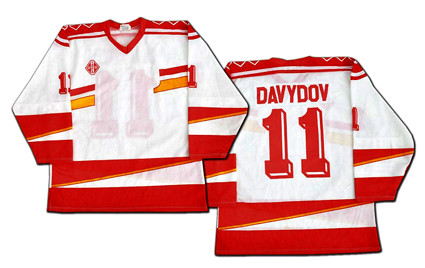
photo courtesy of Classic Auctions

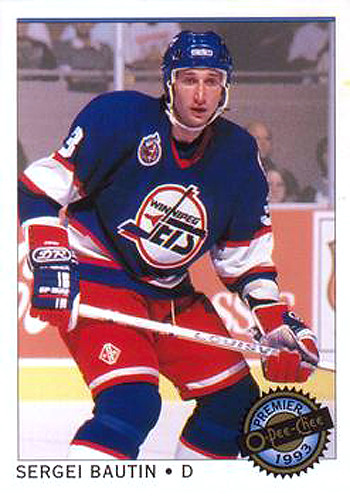
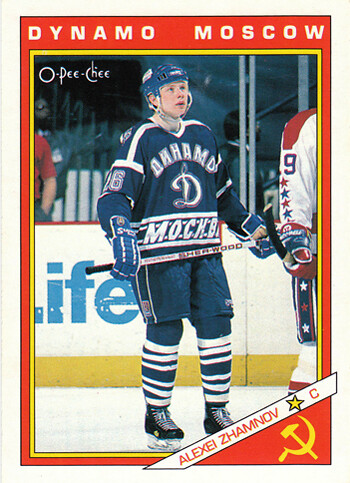
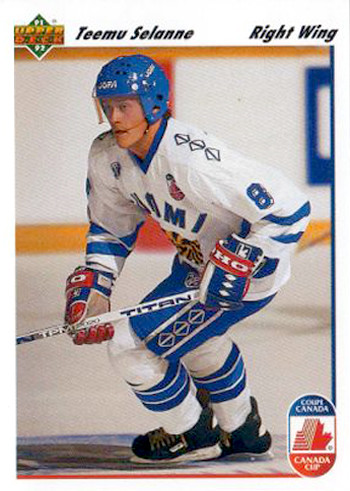
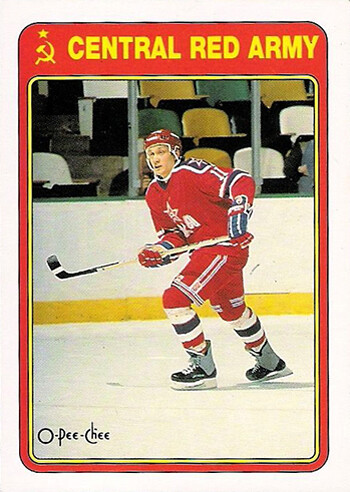
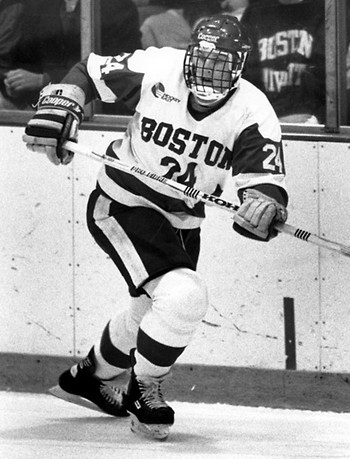
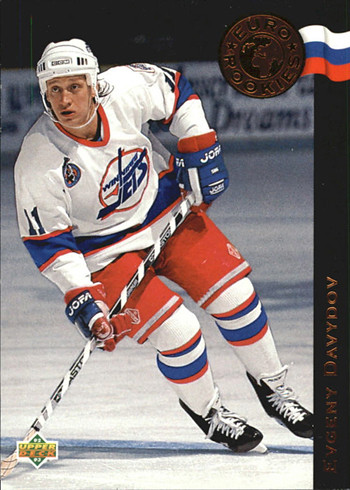
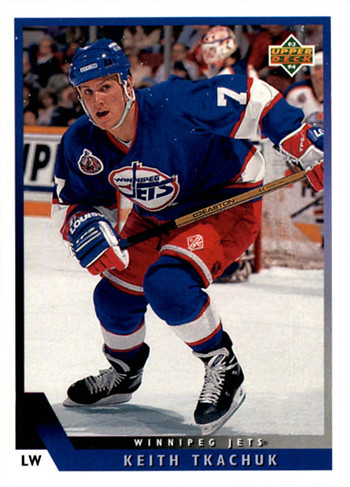
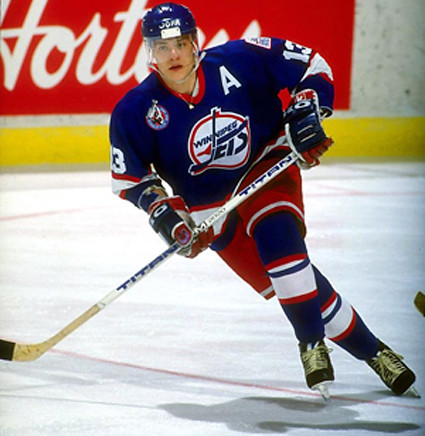
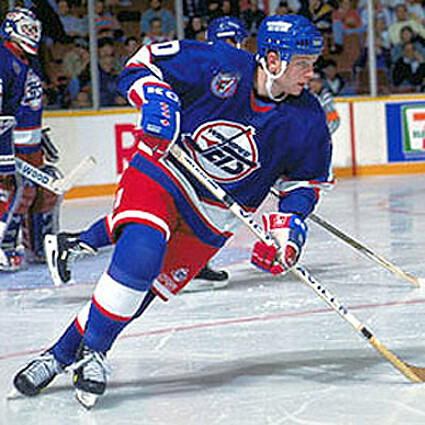
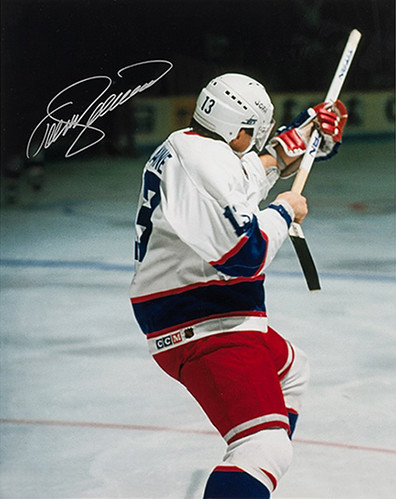
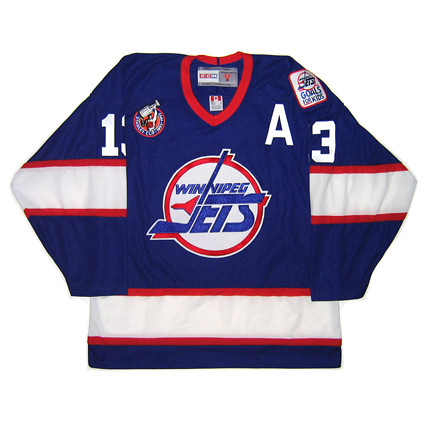
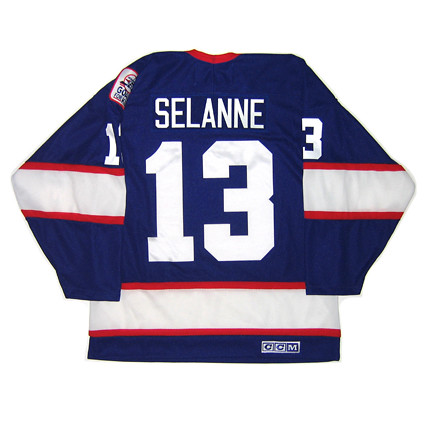
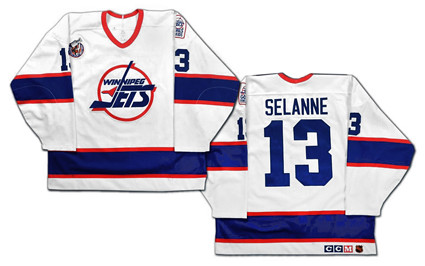
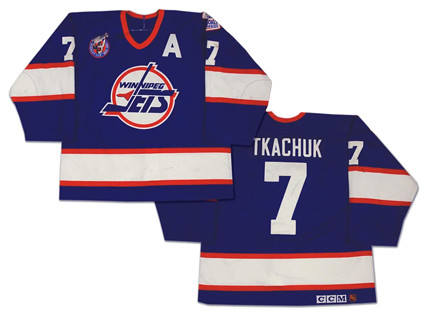
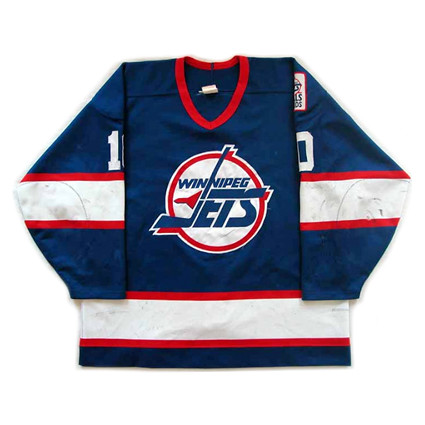
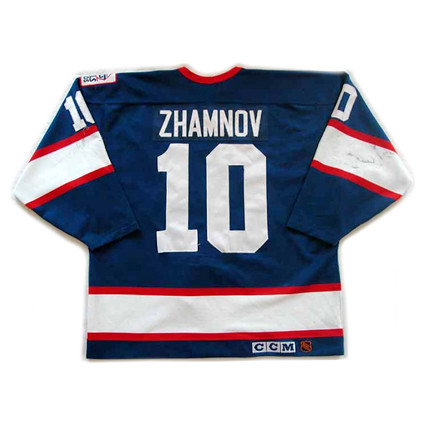
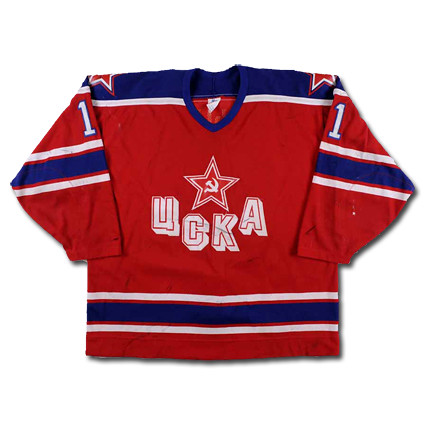
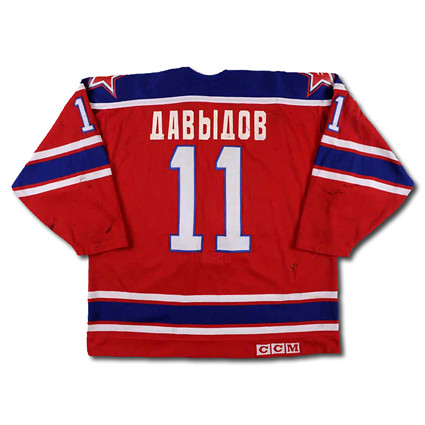
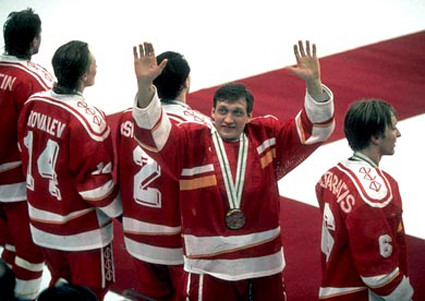










The 1992-93 Winnipeg Jets weren't the first team to have four 20 goal rookies. The 1976-77 Minnesota North Stars were. Roland Eriksson and Glen Sharpley each scored 25, Steve Jensen scored 22, Apex Pirus scored 20
ReplyDelete